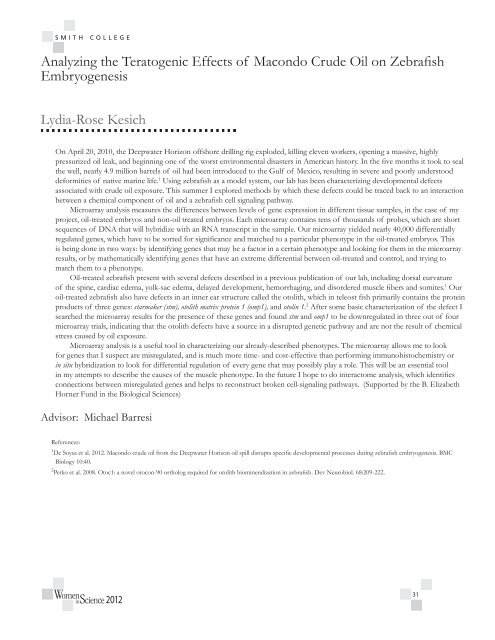Brugia Malayi - Clark Science Center - Smith College
Brugia Malayi - Clark Science Center - Smith College
Brugia Malayi - Clark Science Center - Smith College
You also want an ePaper? Increase the reach of your titles
YUMPU automatically turns print PDFs into web optimized ePapers that Google loves.
Analyzing the Teratogenic Effects of Macondo Crude Oil on Zebrafish<br />
Embryogenesis<br />
Lydia-Rose Kesich<br />
On April 20, 2010, the Deepwater Horizon offshore drilling rig exploded, killing eleven workers, opening a massive, highly<br />
pressurized oil leak, and beginning one of the worst environmental disasters in American history. In the five months it took to seal<br />
the well, nearly 4.9 million barrels of oil had been introduced to the Gulf of Mexico, resulting in severe and poorly understood<br />
deformities of native marine life. 1 Using zebrafish as a model system, our lab has been characterizing developmental defects<br />
associated with crude oil exposure. This summer I explored methods by which these defects could be traced back to an interaction<br />
between a chemical component of oil and a zebrafish cell signaling pathway.<br />
Microarray analysis measures the differences between levels of gene expression in different tissue samples, in the case of my<br />
project, oil-treated embryos and non-oil treated embryos. Each microarray contains tens of thousands of probes, which are short<br />
sequences of DNA that will hybridize with an RNA transcript in the sample. Our microarray yielded nearly 40,000 differentially<br />
regulated genes, which have to be sorted for significance and matched to a particular phenotype in the oil-treated embryos. This<br />
is being done in two ways: by identifying genes that may be a factor in a certain phenotype and looking for them in the microarray<br />
results, or by mathematically identifying genes that have an extreme differential between oil-treated and control, and trying to<br />
match them to a phenotype.<br />
Oil-treated zebrafish present with several defects described in a previous publication of our lab, including dorsal curvature<br />
of the spine, cardiac edema, yolk-sac edema, delayed development, hemorrhaging, and disordered muscle fibers and somites. 1 Our<br />
oil-treated zebrafish also have defects in an inner ear structure called the otolith, which in teleost fish primarily contains the protein<br />
products of three genes: starmaker (stm), otolith matrix protein 1 (omp1), and otolin 1. 2 After some basic characterization of the defect I<br />
searched the microarray results for the presence of these genes and found stm and omp1 to be downregulated in three out of four<br />
microarray trials, indicating that the otolith defects have a source in a disrupted genetic pathway and are not the result of chemical<br />
stress caused by oil exposure.<br />
Microarray analysis is a useful tool in characterizing our already-described phenotypes. The microarray allows me to look<br />
for genes that I suspect are misregulated, and is much more time- and cost-effective than performing immunohistochemistry or<br />
in situ hybridization to look for differential regulation of every gene that may possibly play a role. This will be an essential tool<br />
in my attempts to describe the causes of the muscle phenotype. In the future I hope to do interactome analysis, which identifies<br />
connections between misregulated genes and helps to reconstruct broken cell-signaling pathways. (Supported by the B. Elizabeth<br />
Horner Fund in the Biological <strong>Science</strong>s)<br />
Advisor: Michael Barresi<br />
References:<br />
1 De Soysa et al. 2012. Macondo crude oil from the Deepwater Horizon oil spill disrupts specific developmental processes during zebrafish embryogenesis. BMC<br />
Biology 10:40.<br />
2 Petko et al. 2008. Otoc1: a novel otocon-90 ortholog required for otolith biomineralization in zebrafish. Dev Neurobiol. 68:209-222.<br />
2012<br />
31

















